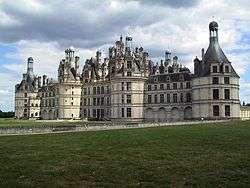French Renaissance architecture

French Renaissance architecture is the name given to the French architecture, between the 15th and early 17th centuries, in different regions of the Kingdom of France. Stylistically, Renaissance architecture followed Gothic architecture (born in France in the 12th century) and was succeeded by Baroque architecture.
History
During the early years of the 16th century the Kingdom of France were involved in wars in northern Italy, bringing back to France not just the Renaissance art treasures, but also stylistic ideas. In the Loire Valley, many Renaissance chateaux appeared at this time, the earliest example being the Château d'Amboise (c. 1495). The style became dominant under Francis I.
The Château de Chambord (1519–1536) is a combination of Gothic structure and Renaissance ornament. It has been said "The delight with which the masons heaped Italian ornament onto the elaborate roofscape belongs to the late gothic spirit of ornamental largesse"[1]
The style progressively developed into a French Mannerism known as the Henry II style under architects such as Sebastiano Serlio, who was engaged after 1540 in work at the Château de Fontainebleau. At Fontainebleau Italian artists such as Rosso Fiorentino, Francesco Primaticcio, and Niccolo dell' Abbate formed the First School of Fontainebleau. Another castle built by Serlio is the Château d'Ancy-le-Franc in Burgundy who was also lavishly decorated by the Flemish and Italian artists from Fontainebleau. Architects such as Philibert Delorme, Androuet du Cerceau, Giacomo Vignola, and Pierre Lescot, were inspired by the new ideas. The southwest interior facade of the Cour Carrée of the Louvre in Paris was designed by Lescot and covered with exterior carvings by Jean Goujon. Architecture continued to thrive in the reigns of Henry II and Henry III.
French Renaissance Revival styles
Other French Revival styles
- Empire style (neoclassical)
See also
| Wikimedia Commons has media related to Renaissance architecture in France. |
References
- ↑ Cropplestone, Trewin (1963). World Architecture. Hamlyn. Page 254